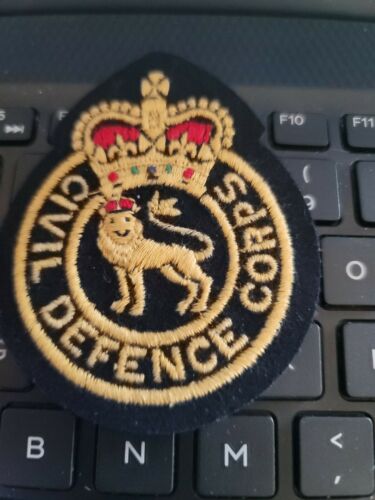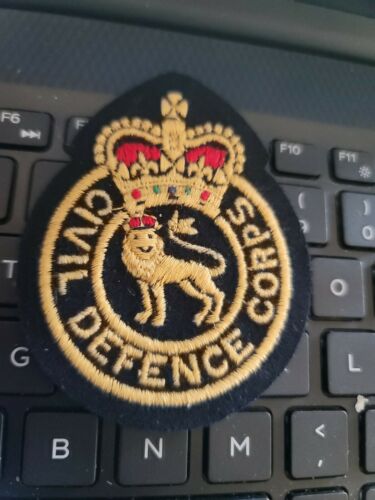-40%
ENGLISH CIVIL DEFENCE CORPS. PATCH--REALTHING 1950s SEE STORE WE HAVE LOTS
$ 1.58
- Description
- Size Guide
Description
PLEASE FOLLOW OUR E BAY STORESEE ALL PICS
WE COMBINE SHIPPING ( no shipping fee for the second item when you buy two or more like items )
SALE
SEE OUR STORE
PLEASE READ WHOLE ADD
Note : I buy and sell excess of ,000.00 a month in military
collectibles a month
, over time you learn what is real and what is not or you do not
survive
. Moth holes are a positive .In all our listing we do make attempt to include some
information
about the items or event the item was used with
article
out of
Wikipedia
or other
reference
sources , speaking as
volunteer
tour guide at the WW2
museum
, you are collecting , buying part of history , I feel very
strongly
you should know the history of what you are buying ,plus I enjoy reading about the item as I post it. ----SO READ THE WHOLE ADD !!!
THIS IS A PERFECT MEDAL TO ADD TO YOUR ORDER AND USE COMBINE SHIPPING , THAT MEANS YOU PAY NO MORE IN SHIPPING WHEN YOU ADD THIS MEDAL TO YOUR ORDER .
ORIGINAL 1950'S ERA BRITISH HOME FRONT CIVIL DEFENCE CORPS UNIFORM PATCH. QUEENS CROWN TO TOP. PATCH MEASURES 3-1/4'' BY 2-1/2'' AND RETAINS IT'S BLACK BACKING MATERIAL. PATCH IS IN VERY GOOD CONDITION,
Civil Defence Corps
From Wikipedia, the free encyclopedia
Jump to navigation
Jump to search
This article
needs additional citations for
verification
.
Please help
improve this article
by
adding citations to reliable sources
. Unsourced material may be challenged and removed.
Find sources:
"Civil Defence Corps"
–
news
·
newspapers
·
books
·
scholar
·
JSTOR
(
February 2013
)
(
Learn how and when to remove this template message
)
The
Civil Defence Corps
(
CDC
) was a civilian volunteer organisation established in
Great Britain
in 1949 to mobilise and take local control of the affected area in the aftermath of a major national emergency, principally envisaged as being a Cold War
nuclear attack
. By March 1956, the Civil Defence Corps had 330,000 personnel.
[1]
It was stood down in Great Britain in 1968, although two Civil Defence Corps still operate within the British Isles, namely the
Isle of Man Civil Defence Corps
and the unrelated
Civil Defence Ireland
in the Republic of Ireland. Many
other countries
maintain a national Civil Defence Corps, usually having a wide brief for assisting in large scale civil emergencies such as flood, earthquake, invasion, or civil disorder.
Organisation
[
edit
]
See also:
Battalions of the Mobile Defence Corps
Although under the authority of the
Home Office
, with a centralised administrative establishment, the corps was administered locally by Corps Authorities. In general every
county
was a Corps Authority, as were most
county boroughs
in
England and Wales
and large
burghs
in
Scotland
. The CDC was never established in
Northern Ireland
. Each Corps Authority established its own Division of the corps.
Each division was divided into several sections:
Headquarters Section, responsible for staffing control centres and divided into three sub-sections.
Intelligence and Operations Sub-Section, responsible for recording and analysing information and preparing instructions.
Signal Sub-Section, responsible for installing, operating and maintaining communications systems.
Scientific and Reconnaissance Sub-Section, responsible for advising controllers on scientific and technical aspects of nuclear, biological and chemical warfare, and providing
reconnaissance
parties (especially to monitor
nuclear fallout
).
Warden Section, responsible for local reconnaissance and reporting, and leadership, organisation, guidance and control of the public.
Rescue Section, responsible for rescue operations,
demolition
and debris clearance.
Ambulance and First Aid Section, built around peacetime local
ambulance
services. This section did not exist in Scotland, where the
Scottish Ambulance Service
was expected to perform ambulance functions and specialist casualty wardens of the Warden Section to perform first aid functions.
Ambulance Sub-Section, responsible for the operation of ambulances to transport casualties to Forward Medical Aid Units (FMAU).
[2]
First Aid Sub-Section, responsible for basic first aid at the scene and the removal of casualties by
stretcher
to ambulances.
Welfare Section, responsible for the welfare of those rendered homeless and/or deprived of normal facilities, including
evacuation
,
accommodation
, feeding,
sanitation
,
clothing
,
nursing
, information etc.
In
London
the
City of London
and
London boroughs
were Corps Authorities, but their divisions only had Headquarters, Warden and Welfare Sections. The
London County Council
organised the Rescue and Ambulance and First Aid Sections centrally and also shared responsibility for the Welfare Sections.
From 1949 to 1968, the Civil Defence Corps Training School was at
Taymouth Castle
in Scotland. The Castle was also one of the sites for
PYTHON
, the plan for
continuity of government
in the event of nuclear war.
[3]
Uniforms and insignia
[
edit
]
Members of the corps were issued with dark blue
battledress
and
berets
. A system of horizontal bars and point-down
chevrons
was used to indicate rank.
Rank Insignia
Intelligence & Operations Sub-Section
Signal Sub-Section
Scientific & Recce Sub-Section
Warden Section
Rescue Section
Welfare Section
Ambulance Sub-Section
First Aid Sub-Section
Division Chief Officer
Chief Warden
Chief Rescue Officer
Chief Welfare Section Officer
Chief Ambulance Officer
Senior Staff Officer
Senior Signal Officer
Senior Scientific Intelligence Officer
Deputy Chief Warden
Deputy Chief Rescue Officer
Deputy Chief Welfare Section Officer
Deputy Chief Ambulance Officer
Column Rescue Officer
Column Ambulance Officer
Assistant Chief Warden
Deputy Column Rescue Officer
Deputy Column Ambulance Officer
Staff Officer (Operations)
Staff Officer (Intelligence)
Sector Staff Officer
Signal Officer
Scientific Intelligence Officer
Reconnaissance Officer
Sector Warden
Company Rescue Officer
Assistant Chief Welfare Section Officer
Company Ambulance Officer
Company First Aid Officer
Deputy Sector Warden
Deputy Company Rescue Officer
Senior Welfare Section Officer
Deputy Company Ambulance Officer
Deputy Company First Aid Officer
Post Warden
Platoon Rescue Officer
Platoon Ambulance Officer
Platoon First Aid Officer
Signalmaster
Deputy Post Warden
Deputy Platoon Rescue Officer
Welfare Section Officer
Deputy Platoon Ambulance Officer
Deputy Platoon First Aid Officer
Operations Clerk
Intelligence Clerk
Signal Clerk
Field Cable Party Leader
Reconnaissance Party Leader
Senior Warden
Rescue Party Leader
Welfare Section Detachment Leader
Ambulance Detachment Leader
First Aid Party Leader
Deputy Rescue Party Leader
Deputy Ambulance Detachment Leader
Deputy First Aid Party Leader
Equipment
[
edit
]
The Civil Defence Corps initially inherited vehicles and equipment that had been stored from the end of the Second World War. However, it was realised that a nuclear attack demanded a different kind of response from the war time experience, potentially wiping out any local emergency response and communications in the affected area, so from 1954 there was a new approach to training and equipment to reflect this.
[1]
This included a new rescue ManPack, and the purchase of new vehicles.
The headquarters sections were equipped with mobile control centres, despatch riders, and
Land Rovers
equipped for reconnaissance (e.g. to measure radiation levels, damage, and road accessibility). These were fitted with radio to communicate back to base, and could carry a second radio for forward communication to personnel on foot. To repair or establish communication, there were also field cable party Land Rovers towing trailers for cable laying.
A reconnaissance detachment comprised four Land Rovers, each with a crew of four (driver, leader/navigator, radiac operator, wireless operator), which would be sent in on three parallel paths towards an area affected by a nuclear strike (with one vehicle spare). The radio operator would be in touch with area control at a base station, which could be a mobile station based in a
Ford Thames
signal office vehicle, or could be in a local town hall. The wireless equipment was Pye or BCC and operated at 155 or 168MHz.
[4]
These mid-1950s radios (like the military equivalent) were 12 volt, using the vehicle supply or batteries. A second 5-channel radio operating at 96Mhz was fitted between the driver and navigator and could be used to communicate with personnel on foot. These vehicles were fitted with hard tops with side windows. The Radiac operator would gather radiation level measurements that would be analysed together with wind patterns by the intelligence section.
The field cable party Land Rovers were soft-tops towing Brockhouse trailers with both cable and poles, so that cables could be carried over roads. Establishment of communications was one of the first priorities. Other vehicles included rescue trucks, equipped with a wide range of rescue equipment and trained staff with Rescue Manpacks, and welfare vehicles, as well as ambulances.
Industrial Civil Defence Service
[
edit
]
The Industrial Civil Defence Service was a similar organisation to the Civil Defence Corps, but separate from it. Every industrial or commercial undertaking which employed two hundred or more people could form a civil defence unit to protect its own property and staff. These units were organised in a similar way to the Civil Defence Corps, with Headquarters, Warden, Rescue, First Aid and Fire Guard Sections. The Fire Guard Section manned fire points and smaller
fire appliances
. Each unit had its own control post, and groups of units could form a group control post. Group control posts and control posts in larger factories had the status of warden posts in their own right, whereas smaller units answered to their local Civil Defence Corps warden post.











